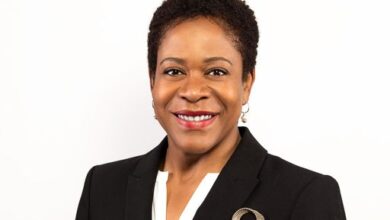News Bureau | ILLINOIS

CHAMPAIGN, Ill. – For much of the 20th century, the African-American image in ads was rare, subservient or worse. Blacks were disregarded as consumers, and the doors to the advertising profession were largely closed, says Jason Chambers, a professor of advertising at the University of Illinois.
The story of how that changed – thanks to pioneers, activists, government action and business self-interest – is the story of Chambers’ new book, “Madison Avenue and the Color Line: African Americans in the Advertising Industry” (University of Pennsylvania Press).
Other books have traced the depiction of blacks in advertisements, but Chambers’ book appears to be the first to tell the inside story of blacks in the ad business itself. He thought the subject important because advertising, as he often tells his students, is “the most visible yet hidden industry in the country … a small industry, but one that has this enormous impact.”
Because of that impact, African Americans in advertising saw themselves as having a “dual responsibility,” Chambers wrote – to their clients in selling products and to the black community in working to change its often negative image in the media.
Early in the century, blacks were portrayed in ads almost always in subservient roles, or as “lazy, ignorant, violent, or as little more than comic relief,” Chambers wrote. Their “lowly status in advertisements confirmed their economic disenfranchisement, just as violence and Jim Crow laws confirmed their political disenfranchisement.”
African Americans trying to break into advertising knew this – knew that “blacks wanted recognition as full and equal members of society and that a key part of that definition lay in their status as consumers,” Chambers wrote. They used that expertise in positioning themselves for employment, and then in making the case for a different and more respectful approach to the black consumer market, he wrote.
Getting to that point, however, first required getting white-owned companies to recognize the black consumer market, and that is where Chambers’ story begins. It was African-American media publishers and executives, needing advertising to support their newspapers and magazines, who began that conversation with white businessmen in the 1930s and 1940s, he said.
In some of their reasoning, documented in correspondence, the white businessmen said they simply saw no need to target African Americans in their advertising, either because they saw no need for a separate approach to that market, or because the market was small, Chambers said. But they also worried that in advertising a given product to blacks, the product might become known as a “black product” and eventually be shunned by whites, he said.
A key turning point came with the magazine Ebony, first published in 1947, Chambers said. Unlike black newspapers, which often served as protest organs, it focused on entertainment, sports and general interest stories, and therefore was more appealing to advertisers.
Over the next two decades, leading up to the mid-1960s, corporate interest in the black consumer market grew and black pioneers in advertising, marketing and public relations moved to take advantage, Chambers said. Among those pioneers were a group of African-American marketing and advertising specialists known as the “Brown Hucksters.”
Even the growing corporate recognition of the black consumer market, however, could not overcome discrimination and the lack of real opportunity for blacks that persisted within the advertising industry, Chambers said. In the 1960s, civil rights groups, through protest and consumer boycotts, worked to bring about concessions from advertisers. Federal and state equal employment commissions – particularly in New York – also had a strong effect, he said.
What followed was a “golden age” for African Americans in the advertising industry, between the mid-1960s and a recession that hit in the mid-1970s, Chambers said. A number of black-owned agencies emerged, and blacks also found new opportunities in mainstream agencies. The period also saw an “explosion of attention from the advertising trade press about ending discrimination in the industry,” he said.
It was from this period that Chambers found the striking image for the cover of his book: a black man in white face paint, with the headline “Mass advertising is color-blind,” used by the black-owned firm Zebra Associates in a 1970 ad to solicit clients.
The accompanying text makes the case that mass advertising “approaches the Black consumer as if he were somebody’s fair-haired boy” and was therefore ineffective with that audience. Zebra, it said, could help “bridge the gap between white advertiser and Black consumer.”
This period also brought the promotion of “positive realism” by Tom Burrell, the African-American co-owner of the Burrell-McBain agency, Chambers said. Avoiding the extremes of wealthy black celebrities or destitute ghetto dwellers, Burrell sought to portray blacks who were in the economic middle and “dying to see themselves as they really are.”
His ads showed blacks in everyday situations, brushing their teeth, washing their cars, doing laundry – just like everyone else, except in an African-American context.
Since the “golden age,” “what racial changes have occurred within the (advertising) agency business have advanced in fits and starts,” Chambers wrote. Blacks remain seriously underrepresented in mainstream agencies even as black athletes, entertainers and music play a larger role in advertisements.
Black-owned agencies continue to do creative work, but also must continue to fight to justify their existence and the necessity of specific advertising aimed at the black consumer market.

























































